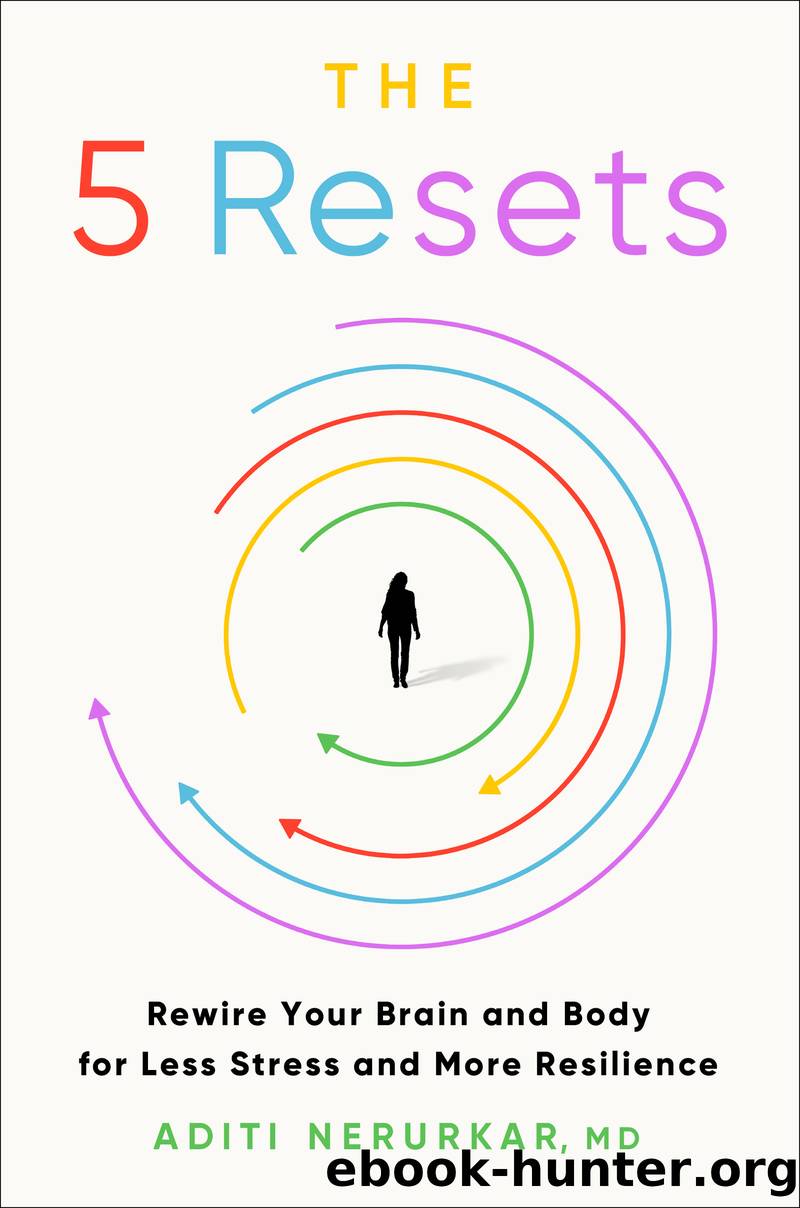The 5 Resets by Dr. Aditi Nerurkar M.D

Author:Dr. Aditi Nerurkar M.D.
Language: eng
Format: epub
Publisher: HarperCollins
Published: 2023-11-08T00:00:00+00:00
Youâll notice that as you practice diaphragmatic breathing, you start to take slower, deeper breaths from your belly area rather than from your chest. Because slower, deeper breathing canât coexist with anxious, shallow, and quick breathing, when you actively practice diaphragmatic breathing during stressful or overwhelming moments, youâre dialing down your stress at the exact moment you need it.
Ryan, my patient from Chapter 3 who was a music industry executive, called me from London one afternoon. He was in a panic. âIâve been sleeping much better, doing my daily prescribed walk and playing my guitar almost every day. Itâs been great,â Ryan told me. âBut I still have this anxiety in meetings and talking to other people. Iâm supposed to connect in person with radio producers before the show today, but Iâm dreading it. Iâve been kicking myself all day for being weak. I never used to be this way.â
Over the phone, I could hear Ryan barely able to catch his breath.
âOkay, Ryan,â I calmly said, âletâs slow down your runaway stress right now. Iâm going to teach you how you can overcome your fight-or-flight response and let your rest-and-digest response take over.â
âHow are you going to do that?â
âWeâre going to use your biology to work for you rather than against you so you can feel calm going into todayâs meetings. Youâre beating yourself up because your biology is actually trying to protect you.â
Over the phone, Ryan and I practiced diaphragmatic breathing together. I asked him to place his hands on his belly, and to make sure his breath was traveling down from his chest into his belly such that he could feel his belly rise and fall with his breathing. In his acutely intense moment of stress, Ryan was learning how to activate his parasympathetic nervous system.
The parasympathetic nervous system leads to your ârest-and-digestâ response. It works in direct opposition to your sympathetic nervous system, which governs your stress pathway through your fight-or-flight response. The really helpful thing is that these two systems are mutually exclusive; they canât be active at the same time. When the sympathetic system is dominant, you feel the effects of high stress. When the parasympathetic system is dominant, you feel calm. Itâs a see-saw effect because they both work in tandem. And the effects of each system are almost immediate.
Ryan and I did a number of deep breaths together, and then I taught him how to do the StopâBreatheâBe technique and encouraged him to use it right before he went to meet with each radio producer.
Ryanâs breathing calmed down over the phone. âThat worked fast! Thank you! Iâm adding that to my new Rule of 2.â
Later that day I got a message from Ryan that his new breathing tools had worked beautifully and he had soared through his interactions with the people he had to meet that day.
Like Ryan, your stress will incrementally decrease over time through the strategies in this book. The tea kettle of stress is all about opening the valve and allowing your brain and body to slowly release the buildup of high stress.
Download
This site does not store any files on its server. We only index and link to content provided by other sites. Please contact the content providers to delete copyright contents if any and email us, we'll remove relevant links or contents immediately.
Bodyweight Strength Training by Jay Cardiello(7192)
Tools of Titans by Timothy Ferriss(6968)
Born to Run: by Christopher McDougall(6280)
Inner Engineering: A Yogi's Guide to Joy by Sadhguru(5914)
Asking the Right Questions: A Guide to Critical Thinking by M. Neil Browne & Stuart M. Keeley(4600)
The Fat Loss Plan by Joe Wicks(4245)
Bodyweight Strength Training Anatomy by Bret Contreras(4067)
Yoga Anatomy by Kaminoff Leslie(3712)
Science and Development of Muscle Hypertrophy by Brad Schoenfeld(3584)
Dynamic Alignment Through Imagery by Eric Franklin(3499)
The Four-Pack Revolution by Chael Sonnen & Ryan Parsons(3487)
ACSM's Complete Guide to Fitness & Health by ACSM(3472)
Yoga Anatomy by Leslie Kaminoff & Amy Matthews(3405)
Bodyweight Strength Training: 12 Weeks to Build Muscle and Burn Fat by Jay Cardiello(3359)
The Ultimate Bodybuilding Cookbook by Kendall Lou Schmidt(3328)
Exercise Technique Manual for Resistance Training by National Strength & Conditioning Association(3299)
Nutrition for Sport, Exercise, and Health by Spano Marie & Kruskall Laura & Thomas D. Travis(3239)
Nutrition for Sport, Exercise, and Health by Marie Spano & Laura Kruskall & D. Travis Thomas(3238)
Yoga Therapy by Mark Stephens(3226)
